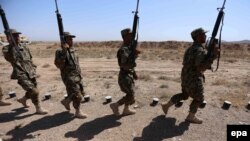USA: Pentagon asked to explain reports of Afghan 'ghost soldiers' on payrolls
| Publisher | Radio Free Europe/Radio Liberty |
| Publication Date | 7 October 2016 |
| Cite as | Radio Free Europe/Radio Liberty, USA: Pentagon asked to explain reports of Afghan 'ghost soldiers' on payrolls, 7 October 2016, available at: https://www.refworld.org/docid/5975a0a111.html [accessed 29 May 2023] |
| Disclaimer | This is not a UNHCR publication. UNHCR is not responsible for, nor does it necessarily endorse, its content. Any views expressed are solely those of the author or publisher and do not necessarily reflect those of UNHCR, the United Nations or its Member States. |
October 07, 2016
 Afghan National Army soldiers participate in a training session in Herat Province. (file photo)
Afghan National Army soldiers participate in a training session in Herat Province. (file photo)
A U.S. government watchdog is asking the Pentagon to explain reports about tens of thousands of nonexistent troops on the payrolls of Afghanistan's security forces.
The Afghan payrolls are heavily funded by international donors.
The U.S. government has allocated more than $68 billion since 2002 to help build and support Afghanistan's national army and police force.
John Sopko, the special inspector-general for Afghanistan reconstruction, said in a letter sent to the Pentagon in August that some of the money could be fraudulently wasted by funding so-called "ghost soldiers" in Afghanistan's security forces.
He noted media reports quoting Afghan officials in Helmand Province who say as many as half the security forces on the payrolls there do not exist and that salaries paid for the nonexistent troops go to corrupt local leaders.
He said those reports "raise questions regarding whether the U.S. government is taking adequate steps to prevent taxpayer funds from being spent on so-called 'ghost' soldiers."
Nationwide, the Afghan National Army and Afghan National Police have a combined official strength of about 320,000 troops. But Afghan authorities say the real number is much lower.
The shortage of troops has been felt during the past year in places like Helmand Province, where the Taliban has won a series of recent military victories against Afghan government forces.
The U.S. Defense Department has tried to prevent fraud by automating some systems and collecting biometric data in order to track the location of police and soldiers.
But Sopko said such measures can only be effective if accurate data on the size of Afghan forces is collected and maintained.
Sopko released his letter publicly on October 7, two days after world powers at a donors conference in Brussels pledged more than $15 billion in aid for Afghanistan over the next four years.
Afghanistan is required to agree to a series of political, economic, and social reforms in return for the funds – including reforms to improve the country's human rights and rein in corruption.
With reporting by Reuters and BBC
Link to original story on RFE/RL website
